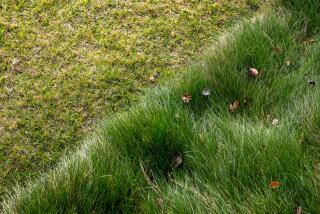Fall Yardwork Is Easier After It Rains
Thank goodness for early rain. Last month’s will make the fall gardening season so much easier. Anything already in the ground has had one good soaking and, for those who haven’t started yet, the soil is wet and workable.
Give it a try and you’ll see that digging is a whole lot easier than it was a couple weeks ago. It should be just right for turning, so if there’s an area where you’ve wanted to improve the soil by adding amendments, now’s the time to do it.
I had one area that needed work, where the hard, grayish soil was cracked from being too long without water. Even when I irrigated, the water seemed to disappear down the big splits in the ground while the soil stayed dry. A neighbor was having similar problems with a lawn he wanted to dig up and sod, but he couldn’t even get a rototiller to dig into his dried-out dirt.
I wanted to replant my little area but first, that soil needed attention, so I got out the spading fork, turned the now-moist soil and broke up all the clods. Then I spread a 3-inch layer of an organic amendment (the kind sold by the bag at nurseries) on top, sprinkled on some soil gypsum and an organic fertilizer, then mixed it all in with the fork, to a depth of about a foot.
When I was done, the dirt had graduated to soil and was soft, dark brown and easily worked--ready for planting. I could have done this at any time, but it is so much easier after a rain, and whenever possible I like to work with nature, not fight it. And nothing wets the soil like a gentle rain.
I think my neighbor gave up just before the rain and called in a crew with a really big tiller, but he’ll still get the benefit of this early rain by sodding soil that is thoroughly wetted, not dusty dry. I hope he remembered amendments.
I moved plants to my little bed, something people are always asking if they can do. If a plant is only a year or two old, it’s often quite easy to dig it up and move it. Beyond a year or two, only a few plants are easily moved, but that includes most perennials, roses, azaleas and even camellias if you’re quite careful.
The trick is timing. You want to move plants when they are getting ready for their winter rest, November and December being the best months.
I have often planted things in the wrong place and have had to move them, this time because one plant was getting too much sun and another too little.
A new plant from New Zealand called silver sword (Astelia nervosa) was getting scorched in the hot spot where I had planted it. The silvery-gray flax-like leaves misled me. It obviously would prefer a smattering of shade, so I carefully dug it up and moved it to a less intense location. A native manzanita wasn’t getting the strong sun it likes, so it too was moved. Each was still only a year old.
To move a plant, have the new hole ready and waiting, then try to dig the plant up so the whole root ball sits in the curve of a shovel and gently carry it to its new home. Set the shovel in the hole and slowly slide it out from underneath the root ball.
This works best if the soil is moist, as it is now, not wet and certainly not dry. Dry soil will simply crumble apart.
While I was working in the garden, I discovered one surprising fact: A few sections of the garden didn’t seem to get wet even after an inch of rain. You can usually expect an inch to soak in about a foot, but there were areas in my garden that were bone dry, probably because our soils shed water like a slicker after being dry so long. It’s a Southern California phenomenon.
The solution is to use a pronged cultivator to break up the hard water-repellent surface so the rain runs into less resistance and can soak in.
This is a good idea at this time of year in drought-resistant gardens, and while you’re at it, spread a mulch over the newly cultivated soil. While cultivating, you’ll also disturb and probably kill any weed seedlings that are trying to germinate with the first rain, and the mulch should prevent others from sprouting.
*
I find a good mulch hard to come by. The best is what tree trimmers have after they’ve run the greenery through a shredder, but try getting some. Next best is shredded bark, though it too can be hard to find (some nurseries sell it by the bag).
Don’t confuse it with ground bark or common pebble bark. The stuff I mean is in long thin shreds that nicely pack down and stay in place. It’s the favorite of several landscape contractors I know, and the bright orange color quickly fades to a soft gray. It’s a very natural-looking mulch.
At this time of year, those with automatically irrigated gardens ought to lengthen the times between waterings on their controllers. Twice a week at this time of year is more than enough. Any more and you may kill plants with too much moisture.
And I hope everyone with timers remembers to turn them off during a rain and leave them off for the next few days. The cool rainy season has arrived, and controllers can be redundant.






